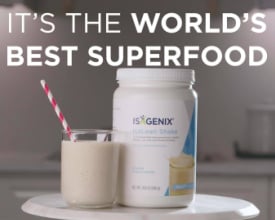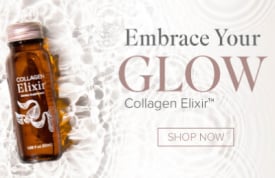Despite our best efforts, we still haven’t managed to stop time.
So Isagenix made IsaGenesis® instead.
It’s more telomere support for your cells, because cellbeing is wellbeing.*
Great health starts from the inside out.
* These statement has not been evaluated by the Food and Drug Administration. This product is not intended to diagnose, treat, cure, or prevent any disease.

Imagine the last time you felt your best — waking up after a good night’s rest or the moment when the endorphins kick in during your run.
Now imagine feeling that way more often.
That’s better health with IsaGenesis (Product B).
Healthy Reminder: For optimal telomere benefits, take as part of your daily Isagenix nutritional system.

The New and Improved Telomere Support
The latest formulation of Product B is so improved, we gave it a new name – IsaGenesis – and it’s scientifically designed to deliver the benefits of Product B you know and love from the previous version in a more powerful, effective way.
IsaGenesis features improved absorbability so that your body can effectively use the plant-based nutrients for superior antioxidant and telomere support in cells where they’re needed.
- Improved absorption for better delivery to cells
- More active ingredients than ever before
- Assists with youthful cell function and healthy telomeres
- Helps neutralize harmful free radicals that can accelerate aging
- Helps protect telomeres for optimal cell function.
- Improves efficiency of natural enzymes increasing antioxidant support

IN A HURRY? Click here to learn more and buy IsaGenesis from Isagenix
What Are Telomeres?
Telomeres are found at the ends of a cell’s chromosomes, and they protect the DNA.
But telomeres shorten over time, exposing chromosomes to oxidative stress and damage.
IsaGenesis helps keep telomeres healthy.
How Does IsaGenesis Help With Youthful Aging?
Still no progress on the whole stopping/reversing time thing — which is OK, that idea wasn’t backed by science anyway.
Fortunately, IsaGenesis is.
We know that oxidative stress and free radicals accelerate the aging process, which is why the antioxidant properties in IsaGenesis are so beneficial to overall health.
What Are The Ingredients In IsaGenesis?
IsaGenesis® provides a unique blend of antioxidants and phytonutrient-rich herbal ingredients. These ingredients reinforce the body’s own defenses against oxidative stress and free radicals that can accelerate the effects of aging.
- Milk thistle — Milk thistle contains compounds including silymarin with demonstrated liver-supporting and free-radical defense properties (6-8).
- Ashwagandha — This popular herb has been used for centuries in Ayurvedic medicine and is known for its benefits in supporting the body’s ability to adapt to stress (9, 10).
- Horny goat weed —This botanical ingredient supports healthy aging through different mechanisms, including support for immune and endocrine systems and benefits for metabolism and organ function (11-16).
- Grape seed extract — Grape seed extract has a high concentration of polyphenol flavonoids, which have been shown to support parameters related to heart health and normal platelet function (17-21).
- Turmeric — This popular curry spice contains curcumin and other related curcuminoid phytonutrients that have benefits for brain and immune health along with support free radical defenses in the body (22, 23).
- Giant knotweed — Giant knotweed is a natural source of the potent phytonutrient resveratrol, also found in red wine, that provides and immune system support and has been linked with benefits for healthy aging (24-26).
- Pomegranate — This fruit has significant beneficial properties related to its natural polyphenol content. It has been linked to benefits for heart health, metabolism, and detoxification systems (27-29).
- White, green, and black tea — Various types of tea leaves contain biologically active compounds associated with many health benefits, including support for cognitive function and the circulatory system (30-33).
- Asian ginseng — Shown to help support normal metabolism and circulation as well as healthy immune response (34, 35).
- Bilberry — Provides support for cognitive function and the brain’s response to oxidative stress (36-41).
- Additionally, vitamin C (ascorbic acid) and B12 (as a mix of methylcobalamin and cyanocobalamin) help combat oxidative stress and support normal metabolism. Vitamin C plays a role in developing and maintaining a healthy antioxidant status (42, 43). Adequate vitamin B12 is essential to maintain normal blood homocysteine levels. Elevated blood homocysteine is a known risk factor for oxidative stress (44, 45).
Who Should Use IsaGenesis?
IsaGenesis is ideal for anyone who wants to support their youthful energy and vitality.
It uses scientifically sound ingredients and is ideal for adults who want to gain the powerful healthy-aging benefits that have been shown to come with healthy telomeres.
This supplement contains no animal byproducts, making it safe for vegetarians and vegans to use.
Due to the powerful nature of the ingredients, do not consume IsaGenesis if you are pregnant or nursing.
How Do I Use IsaGenesis?
One serving of IsaGenesis consists of two softgels.
Adults 18 and older using IsaGenesis should take two servings daily: one in the morning with breakfast and one at lunch or in the evening with dinner, depending on personal preference.
What Are The Benefits Of IsaGenesis?
IsaGenesis is designed to target the ultimate sources of aging.
When combined with Isagenix Systems, this supplement is uniquely designed to offer what Isagenix believes to be the best telomere support on the market— resulting in powerful healthy-aging benefits such as youthful vitality and energy, vital organ support, and healthy immune system support.
You might also like:
How Much Does The Isagenix 30 Day System Cost
How Does The Isagenix Adaptogen Elixir Help With Stress
Before and After Results From Using Isagenix
Isagenix Recharge NAD Supplement for Brain Health
- Bull CF et al. Telomere length in lymphocytes of older South Australian men may be inversely associated with plasma homocysteine. Rejuvenation Res 2009;12:341-9.
- Freitas-Simoes TM, Ros E, Sala-Vila A. Nutrients, foods, dietary patterns and telomere length: Update of epidemiological studies and randomized trials. Metabolism. 2016 Apr;65(4):406-15.
- Wolkowitz OM et al. Leukocyte Telomere Length in Major Depression: Correlations with Chronicity, Inflammation and Oxidative Stress-Preliminary Findings. PLoS One 2011; 6(3):e17837.
- Cassidy A et al. Associations between diet, lifestyle factors, and telomere length in women. Am J Clin Nutr 2010;91:1273-80.
- Demissie S et al. Insulin resistance, oxidative stress, hypertension, and leukocyte telomere length in men from the Framingham Heart Study. Aging Cell 2006; 5: 325-30.
- Sweazea KL, Johnston CS, Knurick J, Bliss CD. Plant-Based Nutraceutical Increases Plasma Catalase Activity in Healthy Participants: A Small Double-Blind, Randomized, Placebo-Controlled, Proof of Concept Trial. J Diet Suppl 2016;0,0:1-14.
- Velussi M et al. Long-term (12 months) treatment with an anti-oxidant drug (silymarin) is effective on hyperinsulinemia, exogenous insulin need and malondialdehyde levels in cirrhotic diabetic patients. J Hepatol 1997;26:871-9.
- Soto C et al. Silymarin increases antioxidant enzymes in alloxan-induced diabetes in rat pancreas. Comp. Biochem. Physiol. C Toxicol. Pharmacol 2003;136:205–212.
- Williamson E. Withania somnifera (L.) Dunal (Solanaceae) In: Major Herbs of Ayurveda. Churchill Livingstone; 2002, 321-325.
- Edwards, S., I. da Costa-Rocha, E.M. Williamson and M. Heinrich, Withania somnifera (L.) Dunal (Solanaceae) Phytopharmacy – an evidence-based guide to herbal medicines. Wiley, Chichester, 2015, 32-35.
- Cooley K et al. Naturopathic care for anxiety: a randomized controlled trial ISRCTN78958974. PLoS One 2009;4:e6628.
- Wu et al. Effect of wolfberry fruit and Epimedium on DNA synthesis of the aging-youth 2BS fusion cells. Zhongguo Zhong Xi Yi Hie He Za Zhi 2003:23;926-928.
- Liu et al. Study on the changes of protein phosphorylation of p65 in lymphocytes of rats in progress of aging and interventional effect of Epimedium flavonoids. China Journal of Chinese Materia Medica 2008;33:73-76.
- Meng et al. Studies on the effect of active constituents of Herba Epimedii on hypothalamic monoamines neurotransmitter and other brain functions in aging rats. China Journal of Chinese Materia Medica 1996;21:683-685.
- Wang et al. Effect of Herba Epimedii and Fructus Lyciion mitochondrial DNA deletion, activity of respiratory chain enzyme complexes and ATP synthesis in aged rats. Journal of Peking University (Health Sci) 1996;21:683-685.
- Zeng et al. Studies on the antioxidant effect of constituents of Herba Epimedii. China Journal of Chinese Materia Medica 1997;22:46-47.
- Niu et al. Study on the savaging activity of Epimedii on hydroxyl radical. Chinese Journal of Sports Medicine;19:434-435.
- Vigna GB et al. Effect of a standardized grape seed extract on low-density lipoprotein susceptibility to oxidation in heavy smokers. Metabolism 2003; 52:1250-7.
- Kar P et al. Effects of grape seed extract in Type 2 diabetic subjects at high cardiovascular risk: a double blind randomized placebo controlled trial examining metabolic markers, vascular tone, inflammation, oxidative stress and insulin sensitivity. Diabet Med 2009;26:526-31.
- Barona J et al. Grape polyphenols reduce blood pressure and increase flow-mediated vasodilation in men with metabolic syndrome. J Nutr 2012;142:1626-32.
- Tome-Carneiro J et al. Consumption of a grape extract supplement containing resveratrol decreases oxidized LDL and ApoB in patients undergoing primary prevention of cardiovascular disease: a triple-blind, 6-month follow-up, placebo-controlled, randomized trial. Mol Nutr Food Res 2012;56:810-21.
- Weseler AR et al. Pleiotropic benefit of monomeric and oligomeric flavanols on vascular health–a randomized controlled clinical pilot study. PLos One 2011;6:328460.
- Nelson SK et al. The induction of human superoxide dismutase and catalase in vivo: a fundamentally new approach to antioxidant therapy. Free Radic Biol Med 2006;40:341-7.
- Pungcharoenkul K and Thongnopnua P. Effect of different curcuminoid supplement dosages on total in vivo antioxidant capacity and cholesterol levels of healthy human subjects. Phytother Res 2011;25:1721-6.
- Xia L et al. Resveratrol reduces endothelial progenitor cells senescence through augmentation of telomerase activity by Akt-dependent mechanisms. Br J Pharmacol 2008;155:387-94.
- Timmers S et al. Calorie restriction-like effects of 30 days of resveratrol supplementation on energy metabolism and metabolic profile in obese humans. Cell Metab 2011;14:612-22.
- Brasnyo P et al. Resveratrol improves insulin sensitivity, reduces oxidative stress and activates the Akt pathway in type 2 diabetic patients. Br J Nutr 2011;106:383-9.
- Rosenblat M et al. Anti-oxidative effects of pomegranate juice (PJ) consumption by diabetic patients on serum and on macrophages. Atherosclerosis 2006;187:363-71.
- Heber D et al. Safety and antioxidant activity of a pomegranate ellagitannin-enriched polyphenol dietary supplement in overweight individuals with increased waist size. J Agr Food Chem 2007;55:10050-4.
- Guo C et al. Pomegranate juice is potentially better than apple juice in improving antioxidant function in elderly subjects. Nutr Res 2008;28:72-7.
- Scholey A et al. Acute neurocognitive effects of epigallocatechin gallate (EGCG). Appetite 2012;58:767-70.
- Wightman EL et al. Epigallocatechin gallate, cerebral blood flow parameters, cognitive performance and mood in healthy humans: a double-blind, placebo-controlled, crossover investigation. Hum Psychopharmacol 2012;27:177-86
- Kuriyama S et al. Green tea consumption and cognitive function: a cross-sectional study from the Tsurugaya Project 1. Am J Clin Nutr 2006;83:355-61.
- Mandel SA et al. Molecular mechanisms of the neuroprotective/neurorescue action of multi-target green tea polyphenols. Front Biosci 2012;4:581-98.
- Ramesh T, Kim SW, Hwang SY, Sohn SH, Yoo SK, Kim SK. Panax ginseng reduces oxidative stress and restores antioxidant capacity in aged rats. Nutr Res 2012;32:718-26.
- Shergis JL, Zhang AL, Zhou W, Xue CC. Panax ginseng in Randomised Controlled Trials: A Systematic Review. Phytother Res 2012.
- Krikorian R, Shidler MD, Nash TA et al. Blueberry supplementation improves memory in older adults. J Agric Food Chem 2010;58:3996-4000.
- Joseph JA, Shukitt-Hale B, Willis LM. Grape juice, berries, and walnuts affect brain aging and behavior. J Nutr 2009;139:1813S-7S.
- Williams CM, El Mohsen MA, Vauzour D et al. Blueberry-induced changes in spatial working memory correlate with changes in hippocampal CREB phosphorylation and brain-derived neurotrophic factor (BDNF) levels. Free Radic Biol Med 2008;45:295-305.
- Legault J, Girard-Lalancette K, Grenon C, Dussault C, Pichette A. Antioxidant activity, inhibition of nitric oxide overproduction, and in vitro antiproliferative effect of maple sap and syrup from Acer saccharum. J Med Food 2010;13:460-8.
- Brewer GJ, Torricelli JR, Lindsey AL et al. Age-related toxicity of amyloid-beta associated with increased pERK and pCREB in primary hippocampal neurons: reversal by blueberry extract. J Nutr Biochem 2009.
- Dulebohn RV, Yi W, Srivastava A, Akoh CC, Krewer G, Fischer JG. Effects of blueberry (Vaccinium ashei) on DNA damage, lipid peroxidation, and phase II enzyme activities in rats. J Agric Food Chem 2008;56:11700-6.
- Groff and Gropper. Advanced Nutrition and Human Metabolism. 5th Ed. Belmont, CA: Wadsworth Learning. 2000.
- Shils et al. Modern Nutrition in Health and Disease. 10th Ed. 2009.
- Fenech M et al. Folate, vitamin B12, homocysteine status and DNA damage in young Australian adults. Carcinogenesis 1998;19:1163-71.




